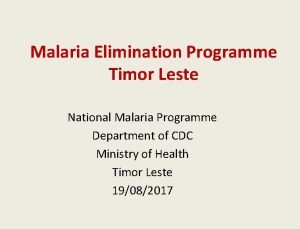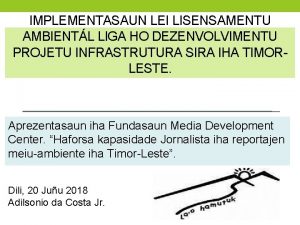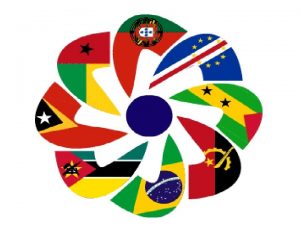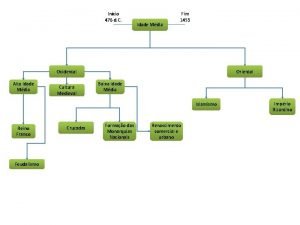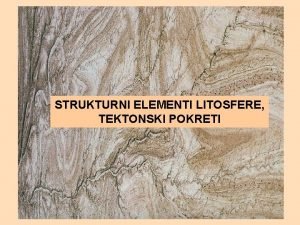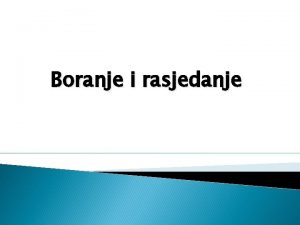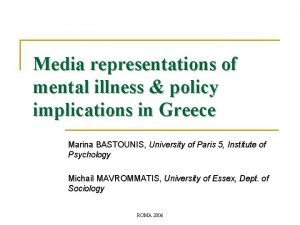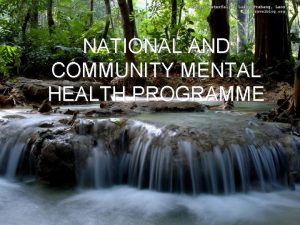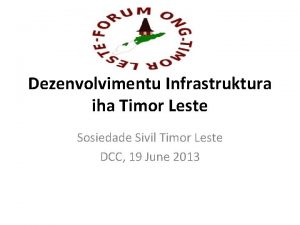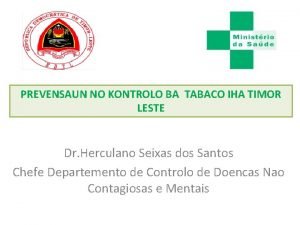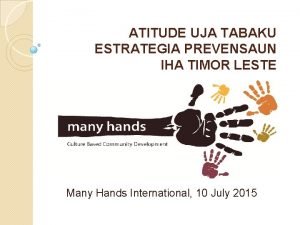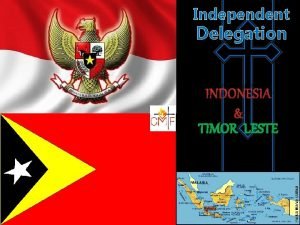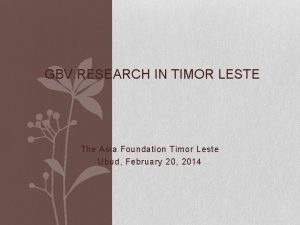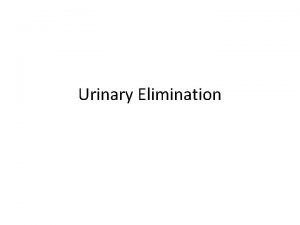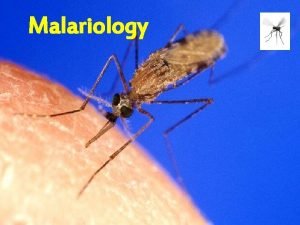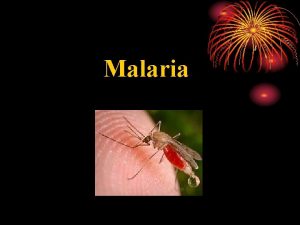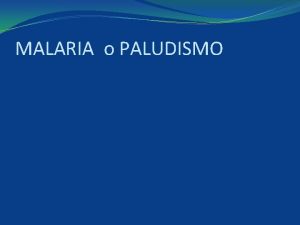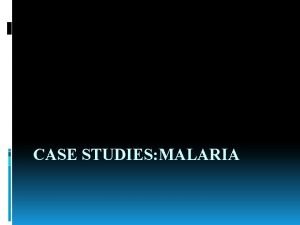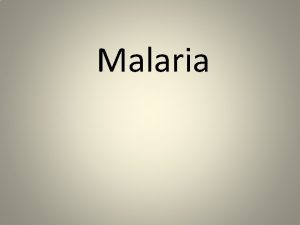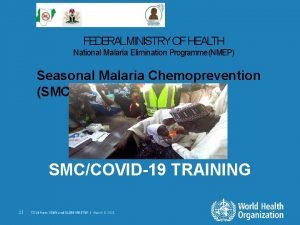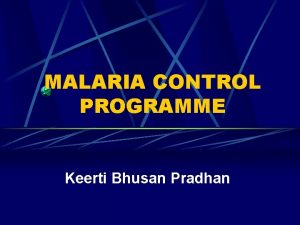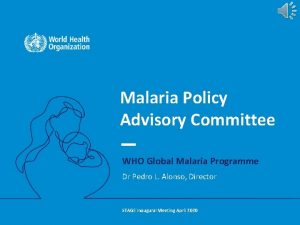Malaria Elimination Programme Timor Leste National Malaria Programme



















- Slides: 19

Malaria Elimination Programme Timor Leste National Malaria Programme Department of CDC Ministry of Health Timor Leste 19/08/2017

National Malaria Programme Success Story: Control to Elimination Phase in 10 years

Number of Malaria Cases Reported and Annual Parasitic Incidence (API) Year No exam. Clinical Conferm slide RDT malaria Malaria Pf Pv Mix Total death API (/1000) 2009 85, 538 34, 152 85, 799 40, 999 34517 12, 246 567 133, 129 56 37 2010 110, 494 85, 751 78, 882 40, 250 28, 350 11, 432 154 119, 072 58 35 2011 81, 172 127, 272 16, 418 19, 740 14, 261 3, 759 1720 36, 153 16 18 2012 64, 318 117, 180 940 5, 208 1, 962 2, 288 958 6, 148 4 5 2013 56, 251 121, 991 17 1, 028 373 512 140 1, 042 3 0. 9 2014 25, 421 70, 618 5 342 118 139 85 347 1 0. 3 2015 30, 253 90, 818 0 80 33 24 23 80 0 0. 07 2016 34, 016 108, 397 1 94 51 11 32 95 0 0. 08

Malaria Incidence per 1000 population from 2011 to 2016 according to municipalities


Malaria Cases 2016 reported in the East & West Timor Border 2016 District Sub District Oecusse Nitibe Pante Makasar Passabe Bobonaro Malina Dili Atauru Don Alexio Eremera Hatolia Viqueque Vatu Carabau TOTAL <5 4 >5 20 M 15 F 9 Border 24 other 5 59 40 24 64 9 1 80 55 1 34 1 89 2 1 1 2 1 10 1 1 1 85 1 1 1 59 1 36 91 1 1 4

Factors that contributed to success Political and financial support and commitment from the Government, Major financial support mainly from the Global Fund starting from 2002 and Rotarian Against Malaria, Australia staring from 2010 Strong Long Term Technical Support from WHO Implementation of evidence based prompt and effective diagnosis and treatment (QC malaria microscopy and RDT, training of clinicians, Therapeutic efficacy study ) Implementation of evidence based vector control programme base on Entomological surveillance findings Community based diagnosis and treatment by the community health Workers in hard to reach areas (30% of the confirmed cases from Community Health Volunteers) High coverage with Long Lasting Insecticide treated nets (> 90% of the risk population) and good quality Indoor Residual Spraying with >90% coverage Strong surveillance, and monitoring and evaluation system Intersectoral collaboration Strong leadership at the central level and a young highly trained and motivated staff

Strong Political Commitment HE Prime Minister, Dr Rui Maria de Araujo, participating in a field visit for active case detection among the vulnerable population HE Prime Minister, Dr Rui Maria de Araujo and Vice Minister of Health, Dr Ana Isabel de Fatima S. Soares visiting a community member house in Hera. Honorable Minister of Health, Dr Maria do Ceu Sarmento Pina da Costa at an event that showcased the national malaria programme focusing on diagnosis of malaria parasites using microscopy.

Universal access to free diagnosis and treatment for malaria Treatment for malaria is free. Health care workers interacting with community informing them about malaria, its diagnosis and treatment Diagnosis of malaria using malaria microscopy

Implementation of evidence based malaria vector control based on entomological surveillance Monitoring the persistence of the insecticide impregnated to the fibers of the nets and mortality rate of the malaria vectors. Entomological surveillance for monitoring of the bionomics of malaria vectors using different entomological techniques for implementation of evidence based vector control. Insecticide resistance monitoring for selection of suitable susceptible insecticide for indoor residual spraying.

Use of Long Lasting Insecticide treated Nets (LLIN) and Indoor Residual Spraying (IRS) in malaria risk areas LLIN being distributed in the community. >80% people in risk areas sleep under a LLIN. IRS : >80% houses fully sprayed with susceptible insecticide in risk areas.

Community based malaria diagnosis and treatment Active case detection in the community Mobile Malaria Clinic

Intersectoral collaboration and community participation Empowering the farmers by providing hands -on training by sensitizing them about various aspects of malaria and pest also which helps them protect against the diseases holistically Community using LLIN as awareness about malaria and its prevention increases. Intersectoral collaboration meeting with Mo. H , Ministry of Agriculture and administration. Monitoring larval density and pest density by farmers. Farmer school-learning by doing. Larval source reduction with farmer community participation.

Strong Monitoring and Evaluation External review of the malaria national programme. Quarterly monitoring and evaluation meeting with municipality malaria officers to assess the progress and learn from others experiences. Monitoring and Evaluation malaria data in the field and at health institutions.

Way forward • Cross border collaboration with West Timor as 98% cases reported from the border • Rapid response to the reported malaria cases to reduce indigenous malaria transmission • Multi sectoral collaboration to reduce malaria transmission due to migrant mobile population and involvement of private health sector • Active case detection through Family Health Programme (Saude na Familia) for finding malaria cases

Funding Gaps • Procurement of Long Lasting Insecticides treated nets to Pregnant Mothers live in Risk areas • Distribution of Long Lasting Insecticides treated nets to the population in malaria risk areas • Procurement of spray machines and spare parts to carry

Funds needed, 2018 -2020 activity No of LLINs /Nets & Sprayers 2018 2019 2020 Total LLINs distribution to Pregnant women live in high risk areas 13022 only -Procurement of Hudson Compression sprayers for IRS 80 2018 13245 13497 39773 51, 373 Estimated budget US$ 2019 2020 Total 52, 170 53, 004 31, 300 82, 673 156, 547 31, 300 239, 392 182, 512 509, 577


Thank you
 Timor leste
Timor leste Saida mak poluisaun
Saida mak poluisaun Pneumoultramicroscopicossilicovulcanoconiótico
Pneumoultramicroscopicossilicovulcanoconiótico Health tb
Health tb Gaussian elimination
Gaussian elimination Translação
Translação Defronte da porta leste da catedral de clermont
Defronte da porta leste da catedral de clermont Plano de melhoria da convivência escolar
Plano de melhoria da convivência escolar Der leste 1
Der leste 1 Timor ili horst
Timor ili horst Spaniard and indian produce a mestizo
Spaniard and indian produce a mestizo Tektonska graba primjer
Tektonska graba primjer Bore i rasjedi
Bore i rasjedi Tektonska graba
Tektonska graba Hic alius magnus timor
Hic alius magnus timor Timor domini significato
Timor domini significato Konkordantni slojevi
Konkordantni slojevi Timor di dio dono dello spirito santo
Timor di dio dono dello spirito santo Conclusion of health and disease
Conclusion of health and disease Objectives of community mental health
Objectives of community mental health
